A Combined Virtual Electrode-Based ESA and CNN Method for MI-EEG Signal Feature Extraction and Classification
Abstract
:1. Introduction
1.1. Literature Survey
1.2. Contributions
2. Materials and Methods
2.1. Overview
- (i)
- The EEG acquisition system was built using a portable electroencephalograph and supporting software, and the signals from 10 subjects performing 6 types of MI tasks (left fist, right fist, left foot, right foot, left thumb, and right thumb). Self-collected data set was established.
- (ii)
- A preprocessing module is used to remove external and internal biological noise interference in the MI-EEG signals.
- (iii)
- After preprocessing, the MI-EEG signals were mapped to the cortex through ESA, and 9 pairs of virtual electrodes were constructed to obtain the source signals. JTFA was performed to extract joint time–frequency feature information.
- (iv)
- A 6-classification CNN model was constructed, using a 4-layer CNN structure to learn signal features, 4-layer max-pooling for dimensionality reduction, and FC layer for classification of MI tasks.
- (v)
- The control strategy module converted the classification results of the CNN model into control instructions, and then transmitted them to the smart car via wireless Bluetooth.
- (vi)
- The motion state of the smart car is fed back to the subject for verification and judgment.
- (vii)
- Based on the self-collected data set, the experiments were conducted to verify the classification effect of the MI-BCI system, and the results were analyzed and optimized.
2.2. Data Acquisition and Preprocessing
2.3. EEG Source Analysis
2.3.1. Forward Problem
2.3.2. Inverse Problem
2.4. Feature Extraction
2.5. CNN Classification
3. Results
3.1. Denoising Results
3.2. Feature Extraction Results
3.3. Classification Results
3.4. MI-BCI System Experiment Result
4. Discuss
4.1. Training Duration Effect
4.2. Individual Difference Effect
4.3. Comparison with Other Works
5. Conclusions
Author Contributions
Funding
Institutional Review Board Statement
Informed Consent Statement
Data Availability Statement
Conflicts of Interest
References
- Nguyen, C.H.; Artemiadis, P. EEG feature descriptors and discriminant analysis under Riemannian Manifold perspective. Neurocomputing 2018, 275, 1871–1883. [Google Scholar] [CrossRef]
- Meziani, A.; Djouani, K.; Medkour, T.; Chibani, A. A Lasso quantile periodogram based feature extraction for EEG-based motor imagery. J. Neurosci. Methods 2019, 328, 108434. [Google Scholar] [CrossRef]
- Mebarkia, K.; Reffad, A. Multi optimized SVM classifiers for motor imagery left and right hand movement identification. Australas. Phys. Eng. Sci. Med. 2019, 42, 949–958. [Google Scholar] [CrossRef] [PubMed]
- Bouton, C.E.; Shaikhouni, A.; Annetta, N.V.; Bockbrader, M.A.; Friedenberg, D.A.; Nielson, D.M.; Sharma, G.; Sederberg, P.B.; Glenn, B.C.; Mysiw, W.J.; et al. Restoring cortical control of functional movement in a human with quadriplegia. Nature 2016, 533, 247–250. [Google Scholar] [CrossRef] [PubMed]
- Schwemmer, M.A.; Skomrock, N.D.; Sederberg, P.B.; Ting, J.E.; Sharma, G.; Bockbrader, M.A.; Friedenberg, D.A. Meeting brain-computer interface user performance expectations using a deep neural network decoding framework. Nat. Med. 2018, 24, 1669–1676. [Google Scholar] [CrossRef] [PubMed]
- Atum, Y.; Pacheco, M.; Acevedo, R.; Tabernig, C.; Manresa, J.B. A comparison of subject-dependent and subject -independent channel selection strategies for single-trial P300 brain computer interfaces. Med. Biol. Eng. Comput. 2019, 57, 2705–2715. [Google Scholar] [CrossRef] [PubMed]
- Joana, P.; Ioana, S.A.; Müller-Putz, G.R. EEG patterns of self-paced movement imaginations towards externally-cued and internally-selected targets. Sci. Rep. 2018, 8, 13394. [Google Scholar] [CrossRef]
- Lai, C.Q.; Ibrahim, H.; Abdullah, M.Z.; Abdullah, J.M.; Suandi, S.A.; Azman, A. Current Practical Applications of Electroenc- ephalography. J. Comput. Theor. Nanosci. 2019, 16, 4943–4953. [Google Scholar] [CrossRef]
- Reshmi, G.; Amal, A. Design of a BCI System for Piloting a Wheelchair Using Five Class MI Based EEG. In Proceedings of the Third International Conference on Advances in Computing & Communications IEEE Computer Society 2013, Cochin, India, 29–31 August 2013. [Google Scholar] [CrossRef]
- Choi, J.; Kim, H. Real-time Decoding of EEG Gait Intention for Controlling a Lower-limb Exoskeleton System. In Proceedings of the 7th International Winter Conference on Brain-Computer Interface (BCI), Gangwon, Republic of Korea, 18–20 February 2019. [Google Scholar] [CrossRef]
- Ko, L.W.; Komarov, O.; Lin, S.C. Enhancing the Hybrid BCI Performance with the Common Frequency Pattern in Dual-Channel EEG. IEEE Trans. Neural Syst. Rehabil. Eng. 2019, 27, 1360–1369. [Google Scholar] [CrossRef]
- Kus, R.; Valbuena, D.; Zygierewicz, J.; Malechka, T.; Graeser, A.; Durka, P. Asynchronous BCI Based on Motor Imagery with Automated Calibration and Neurofeedback Training. Neural Syst. Rehabil. Eng. 2012, 20, 823–835. [Google Scholar] [CrossRef]
- Dose, H.; Møller, J.S.; Iversen, H.K.; Puthusserypady, S. An end-to-end deep learning approach to MI-EEG signal classification for BCIs. Expert Syst. Appl. 2018, 114, 532–542. [Google Scholar] [CrossRef]
- Hayet, I.; Haq, T.F.; Mahmud, H.; Hasan, K. Designing a Hierarchical Keyboard Layout for Brain-Computer Interface Based Text Entry. In Proceedings of the 2019 International Conference on Electrical, Computer and Communication Engineering (ECCE) IEEE, Cox’sBazar, Bangladesh, 7–9 February 2019. [Google Scholar] [CrossRef]
- Miladinović, A.; Ajčević, M.; Jarmolowska, J.; Marusic, U.; Silveri, G.; Battaglini, P.P.; Accardo, A. Performance of EEG Motor-Imagery based spatial filtering methods: A BCI study on Stroke patients. Procedia Comput. Sci. 2020, 176, 2840–2848. [Google Scholar] [CrossRef]
- Ang, K.K.; Guan, C.; Chua, K.S.G.; Ang, B.T.; Kuah, C.; Wang, C.; Phua, K.S.; Chin, Z.Y.; Zhang, H. Clinical study of neurorehabilitation in stroke using EEG-based motor imagery brain-computer interface with robotic feedback. In Proceedings of the 2010 Annual International Conference of the IEEE Engineering in Medicine and Biology, Buenos Aires, Argentina, 31 August–4 September 2010. [Google Scholar] [CrossRef]
- Pfurtscheller, G.; Neuper, C.; Guger, C.; Harkam, W.; Ramoser, H.; Schlogl, A.; Obermaier, B.; Pregenzer, M. Current trends in Graz Brain-Computer Interface (BCI) research. IEEE Trans. Rehabil. Eng. 2000, 8, 216–219. [Google Scholar] [CrossRef] [PubMed]
- Wolpaw, J.R.; Birbaumer, N.; McFarland, D.J.; Pfurtscheller, G.; Vaughan, T.M. Brain-computer interfaces for communication and control. Clin. Neurophysiol. 2002, 113, 767–791. [Google Scholar] [CrossRef] [PubMed]
- Pfurtscheller, G.; Neuper, C. Motor imagery and direct brain-computer communication. Proc. IEEE 2001, 89, 1123–1134. [Google Scholar] [CrossRef]
- Vidaurre, C.; Sannelli, C.; Müller, K.-R.; Blankertz, B. Machine-Learning-Based Coadaptive Calibration for Brain-Computer Interfaces. Neural Comput. 2011, 23, 791–816. [Google Scholar] [CrossRef]
- Salleh, S.Z. Control of one-dimensional cursor movement by noninvasive brain-computer interface in humans. Proc. Natl. Acad. Sci. USA 2004, 101, 17849–17854. [Google Scholar] [CrossRef]
- Millán, J.D.R.; Rupp, R.; Müller-Putz, G.R.; Murray-Smith, R.; Giugliemma, C.; Tangermann, M.; Vidaurre, C.; Cincotti, F.; Kübler, A.; Leeb, R.; et al. Combining Brain–Computer Interfaces and Assistive Technologies: State-of-the-Art and Challenges. Front. Neurosci. 2010, 4, 161. [Google Scholar] [CrossRef]
- Pfurtscheller, G.; Brunner, C.; Schlögl, A.; da Silva, F.L. Mu rhythm (de)synchronization and EEG single-trial classification of different motor imagery tasks. Neuroimage 2006, 31, 153–159. [Google Scholar] [CrossRef]
- Allison, B.Z.; Wolpaw, E.W.; Wolpaw, J.R. Brain-computer interface systems: Progress and prospects. Expert Rev. Med. Devices 2007, 4, 463–474. [Google Scholar] [CrossRef]
- Wolpaw, J.; Birbaumer, N.; Heetderks, W.; McFarland, D.; Peckham, P.; Schalk, G.; Donchin, E.; Quatrano, L.; Robinson, C.; Vaughan, T. Brain-computer interface technology: A review of the first international meeting. IEEE Trans. Rehabil. Eng. 2000, 8, 164–173. [Google Scholar] [CrossRef] [PubMed]
- Schalk, G.; McFarland, D.; Hinterberger, T.; Birbaumer, N.; Wolpaw, J. BCI2000, A general-purpose brain-computer interface (BCI) system. IEEE Trans. Biomed. Eng. 2004, 51, 1034–1043. [Google Scholar] [CrossRef] [PubMed]
- Muller-Putz, G.R.; Ofner, P.; Schwarz, A.; Pereira, J.; Pinegger, A.; Dias, C.L.; Hehenberger, L.; Kobler, R.; Sburlea, A.I. Towards non-invasive EEG-based arm/hand-control in users with spinal cord injury. In Proceedings of the 5th International Winter Conference on Brain-Computer Interface (BCI). IEEE, Gangwon, Republic of Korea, 9–11 January 2017; pp. 63–65. [Google Scholar] [CrossRef]
- Müller-Putz, G.R.; Schwarz, A.; Pereira, J.; Ofner, P. From Classic Motor Imagery to Complex Movement Intention Decoding: The Noninvasive Graz-BCI Approach. Prog. Brain Res. 2016, 228, 39–70. [Google Scholar] [CrossRef] [PubMed]
- Garcia, A.P.; Schjlberg, I.; Gale, S. EEG control of an industrial robot manipulator. In Proceedings of the IEEE 4th International Conference on Cognitive Infocommunications, Budapest, Hungary, 2–5 December 2013. [Google Scholar] [CrossRef]
- He, B.; Baxter, B.; Edelman, B.J.; Cline, C.C.; Ye, W.W. Noninvasive Brain-Computer Interfaces Based on Sensorimotor Rhythms. Proc. IEEE 2015, 103, 907–925. [Google Scholar] [CrossRef]
- Leeb, R.; Tonin, L.; Rohm, M.; Desideri, L.; Carlson, T.; Millan, J.d.R. Towards Independence: A BCI Telepresence Robot for People with Severe Motor Disabilities. Proc. IEEE 2015, 103, 969–982. [Google Scholar] [CrossRef]
- Bartur, G.; Pratt, H.; Soroker, N. Changes in Mu and Beta Amplitude of the EEG during Upper Limb Movement Correlate with Motor Impairment and Structural Damage in Subacute Stroke. Clin. Neurophysiol. 2019, 130, 1644–1651. [Google Scholar] [CrossRef] [PubMed]
- Chen, X.; Wang, Y.; Nakanishi, M.; Gao, X.; Jung, T.-P.; Gao, S. High-speed spelling with a noninvasive brain-computer interface. Proc. Natl. Acad. Sci. USA 2015, 12, 6058–6067. [Google Scholar] [CrossRef]
- Wu, Y.; Wang, C.; Zhu, Y.; Wang, C.; Niu, Y.; Shao, Z.; Gao, X.; Zhao, Z.; Yu, Y. Investigators at Xinxiang Medical University Detail Findings in Networks (Mi-eeg Classification Using Shannon Complex Wavelet and Convolutional Neural Networks). Network Daily News. Appl. Soft Comput. 2022, 130, 109685. [Google Scholar] [CrossRef]
- Ma, X.; Chen, W.; Pei, Z.; Liu, J.; Huang, B.; Chen, J. A Temporal Dependency Learning CNN with Attention Mechanism for MI-EEG Decoding. IEEE Trans. Neural Syst. Rehabil. Eng. 2023, 31, 3188–3200. [Google Scholar] [CrossRef]
- Altaheri, H.; Muhammad, G.; Alsulaiman, M.; Amin, S.U.; Altuwaijri, G.A.; Abdul, W.; Bencherif, M.A.; Faisal, M. Deep learning techniques for classification of electroencephalogram (EEG) motor imagery (MI) signals: A review. Neural Comput. Appl. 2023, 35, 14681–14722. [Google Scholar] [CrossRef]
- Ang, K.K.; Guan, C.; Phua, K.S.; Wang, C.; Zhou, L.; Tang, K.Y.; Joseph, G.J.E.; Kuah, C.W.K.; Chua, K.S.G. Brain-computer interface-based robotic end effector system for wrist and hand rehabilitation: Results of a three-armed randomized controlled trial for chronic stroke. Front. Neuroeng. 2014, 7, 30. [Google Scholar] [CrossRef]
- Pichiorri, F.; Morone, G.; Petti, M.; Toppi, J.; Pisotta, I.; Molinari, M.; Paolucci, S.; Inghilleri, M.; Astolfi, L.; Cincotti, F.; et al. Brain–computer interface boosts motor imagery practice during stroke recovery. Ann. Neurol. 2015, 77, 851–865. [Google Scholar] [CrossRef]
- Zander, T.O.; Krol, L.R.; Birbaumer, N.P.; Gramann, K. Neuroadaptive technology enables implicit cursor control based on medial prefrontal cortex activity. Proc. Natl. Acad. Sci. USA 2016, 113, 14898–14903. [Google Scholar] [CrossRef] [PubMed]
- Lin, C.T.; Lin, F.C.; Chen, S.A.; Lu, S.-W.; Chen, T.-C.; Ko, L.-W. EEG-based Brain-computer Interface for Smart Living Environmental Auto-adjustment. J. Med. Biol. Eng. 2010, 30, 237–245. [Google Scholar] [CrossRef]
- Nam, C.S.; Nijholt, A.; Lotte, F. Brain-Computer Interfaces Handbook: Technological and Theoretical Advances; CRC Press: Boca Raton, FL, USA, 2018. [Google Scholar] [CrossRef]
- Lebedev, M.A.; Nicolelis, M.A.L. Brain–machine interfaces: Past, present and future. Trends Neurosci. 2006, 29, 536–546. [Google Scholar] [CrossRef] [PubMed]
- Donati, A.R.C.; Shokur, S.; Morya, E.; Campos, D.S.F.; Moioli, R.C.; Gitti, C.M.; Augusto, P.B.; Tripodi, S.; Pires, C.G.; Pereira, G.A.; et al. Long-Term Training with a Brain-Machine Interface-Based Gait Protocol Induces Partial Neurological Recovery in Paraplegic Patients. Sci. Rep. 2016, 6, 30383. [Google Scholar] [CrossRef]
- Monti, F.; Boscaini, D.; Masci, J. Geometric deep learning on graphs and manifolds using mixture model CNNs. In Proceedings of the IEEE Conference on Computer Vision and Pattern Recognition, Honolulu, HI, USA, 21–26 July 2017; pp. 5115–5124. [Google Scholar] [CrossRef]
- Gao, H.; Wang, Z.; Ji, S. Large-scale learnable graph convolutional networks. In Proceedings of the 24th ACM SIGKDD International Conference on Knowledge Discovery & Data Mining, London, UK, 19–23 August 2018; pp. 1416–1424. [Google Scholar] [CrossRef]
- Al-Saegh, A.; Dawwd, S.A.; Abdul-Jabbar, J.M. Deep learning for motor imagery EEG-based classification: A review. Biomed. Signal Process. Control. 2021, 63, 102–172. [Google Scholar] [CrossRef]
- Blankertz, B.; Sannelli, C.; Halder, S.; Hammer, E.M.; Kübler, A.; Müller, K.-R.; Curio, G.; Dickhaus, T. Neurophysiological predictor of SMR-based BCI performance. Neuroimage 2010, 51, 1303–1309. [Google Scholar] [CrossRef]
- Wang, Y.; Gotman, J. The influence of electrode location errors on EEG dipole source localization with a realistic head model. Clin. Neurophysiol. 2001, 112, 1777–1780. [Google Scholar] [CrossRef]
- Yuan, H.; Liu, T.; Szarkowski, R.; Rios, C.; Ashe, J.; He, B. Negative covariation between task-related responses in alpha/beta-band activity and BOLD in human sensorimotor cortex: An EEG and fMRI study of motor imagery and movements. Neuroimage 2010, 49, 2596–2606. [Google Scholar] [CrossRef]
- Liu, F.; Rosenberger, J.; Lou, Y.; Hosseini, R.; Su, J.; Wang, S. Graph Regularized EEG Source Imaging with In-Class Consistency and Out-Class Discrimination. IEEE Trans. Big Data 2017, 3, 378–391. [Google Scholar] [CrossRef]
- Michel, C.M.; Murray, M.M.; Lantz, G.; Gonzalez, S.; Spinelli, L.; de Peralta, R.G. EEG source imaging. Clin. Neurophysiol. 2004, 115, 2195–2222. [Google Scholar] [CrossRef]
- Kybic, J.; Clerc, M.; Abboud, T.; Faugeras, O.; Keriven, R.; Papadopoulo, T. A common formalism for the Integral formulations of the forward EEG problem. IEEE Trans. Med. Imaging 2005, 24, 12. [Google Scholar] [CrossRef]
- Patil, A.L.; Deepak, K.K.; Kochhar, K.P. Role of prefrontal cortex during Sudoku task: fNIRS study. Transl. Neurosci. 2020, 11, 419–427. [Google Scholar] [CrossRef]
- Lehmann, D.; Faber, P.L.; Gianotti, L.R.; Kochi, K.; Pascual-Marqui, R.D. Coherence and phase locking in the scalp EEG and between LORETA model sources, and microstates as putative mechanisms of brain temporo-spatial functional organization. J. Physiol. Paris 2006, 99, 29–36. [Google Scholar] [CrossRef] [PubMed]
- Pascual-Marqui, R.D. Standardized low-resolution brain electromagnetic tomography (sLORETA): Technical details. Methods Find Exp. Clin. Pharm. 2002, 24 (Suppl. SD), 5–12. [Google Scholar] [CrossRef]
- Wu, H.; Niu, Y.; Li, F.; Li, Y.; Fu, B.; Shi, G.; Dong, M. A Parallel Multiscale Filter Bank Convolutional Neural Networks for Motor Imagery EEG Classification. Front. Neurosci. 2019, 13, 1275. [Google Scholar] [CrossRef]
- Mohseni, M.; Shalchyan, V.; Jochumsen, M.; Niazi, I.K. Upper Limb Complex Movements Decoding From Pre-Movement EEG Signals Using Wavelet Common Spatial Patterns. Comput. Methods Programs Biomed. 2019, 183, 105076. [Google Scholar] [CrossRef] [PubMed]
- Zhang, Y.; Zhang, X.; Sun, H.; Fan, Z.; Zhong, X. Portable brain-computer interface based on novel convolutional neural network. Comput. Biol. Med. 2019, 107, 248–256. [Google Scholar] [CrossRef] [PubMed]
- Zuo, R.; Wei, J.; Li, X.; Li, C.; Zhao, C.; Ren, Z.; Liang, Y.; Geng, X.; Jiang, C.; Yang, X.; et al. Automated Detection of High-Frequency Oscillations in Epilepsy Based on a Convolutional Neural Network. Front. Comput. Neurosci. 2019, 13, 6. [Google Scholar] [CrossRef] [PubMed]
- Zhang, X.; Xu, G.; Mou, X.; Ravi, A.; Li, M.; Wang, Y.; Jiang, N. A Convolutional Neural Network for the Detection of Asynchronous Steady State Motion Visual Evoked Potential. IEEE Trans. Neural Syst. Rehabil. Eng. 2019, 27, 1303–1311. [Google Scholar] [CrossRef]
- Podmore, J.J.; Breckon, T.P.; Aznan, N.K.N.; Connolly, J.D. On the Relative Contribution of Deep Convolutional Neural Networks for SSVEP-Based Bio-Signal Decoding in BCI Speller Applications. IEEE Trans. Neural Syst. Rehabil. Eng. 2019, 27, 611–618. [Google Scholar] [CrossRef] [PubMed]
- Acharya, U.R.; Oh, S.L.; Hagiwara, Y.; Tan, J.H.; Adeli, H. Deep convolutional neural network for the automated detection and diagnosis of seizure using EEG signals. Comput. Biol. Med. 2018, 100, 270–278. [Google Scholar] [CrossRef] [PubMed]
- Khessiba, S.; Blaiech, A.G.; Ben Khalifa, K.; Ben Abdallah, A.; Bedoui, M.H. Correction to: Innovative deep learning models for EEG-based vigilance detection. Neural Comput. Appl. 2021, 34, 819. [Google Scholar] [CrossRef]
- Bouny, L.E.; Khalil, M.; Adib, A. An End-to-End Multi-Level Wavelet Convolutional Neural Networks for heart diseases diagnosis—ScienceDirect. Neurocomputing 2020, 417, 187–201. [Google Scholar] [CrossRef]
- Zihan, C.; Zhang, Y.; Chen, W. Electricity price prediction based on hybrid model of adam optimized LSTM neural network and wavelet transform. Energy 2019, 187, 115804. [Google Scholar] [CrossRef]
- Müller-Putz, G.R.; Scherer, R.; Brauneis, C.; Pfurtscheller, G. Steady-state visual evoked potential (SSVEP)-based communication: Impact of harmonic frequency components. J. Neural Eng. 2005, 2, 123–130. [Google Scholar] [CrossRef] [PubMed]
- Blankertz, B.; Muller, K.-R.; Krusienski, D.; Schalk, G.; Wolpaw, J.; Schlogl, A.; Pfurtscheller, G.; Millan, J.; Schroder, M.; Birbaumer, N. The BCI competition III: Validating alternative approaches to actual BCI problems. IEEE Trans. Neural Syst. Rehabil. Eng. 2006, 14, 153–159. [Google Scholar] [CrossRef]
- Ramos, A.; Halder, S.; Birbaumer, N. Proprioceptive feedback in BCI. In Proceedings of the International IEEE/EMBS Conference on Neural Engineering, Antalya, Turkey, 29 April–2 May 2009. [Google Scholar] [CrossRef]
- Handiru, V.S.; Prasad, V.A. Optimized Bi-Objective EEG Channel Selection and Cross-Subject Generalization with Brain–Computer Interfaces. IEEE Trans. Hum.-Mach. Syst. 2016, 46, 777–786. [Google Scholar] [CrossRef]
- Kim, Y.; Ryu, J.; Kim, K.K.; Took, C.C.; Mandic, D.P.; Park, C. Motor Imagery Classification Using Mu and Beta Rhythms of EEG with Strong Uncorrelating Transform Based Complex Common Spatial Patterns. Comput. Intell. Neurosci. 2016, 1489692. [Google Scholar] [CrossRef]
- Ma, X.; Qiu, S.; Du, C.; Xing, J.; He, H. Improving EEG-Based Motor Imagery Classification via Spatial and Temporal Recurrent Neural Networks. In Proceedings of the 2018 40th Annual International Conference of the IEEE Engineering in Medicine and Biology Society (EMBC), Honolulu, HI, USA, 18–21 July 2018; pp. 1903–1906. [Google Scholar] [CrossRef]
- Hou, Y.; Zhou, L.; Jia, S.; Lun, X. A novel approach of decoding EEG four-class motor imagery tasks via scout ESI and CNN. J. Neural Eng. 2020, 17, 16048. [Google Scholar] [CrossRef] [PubMed]
- Alyasseri, Z.A.A.; Khader, A.T.; Al-Betar, M.A.; Alomari, O.A. Person Identification using EEG Channel Selection with Hybrid Flower Pollination Algorithm. Pattern Recognit. 2020, 105, 107393. [Google Scholar] [CrossRef]

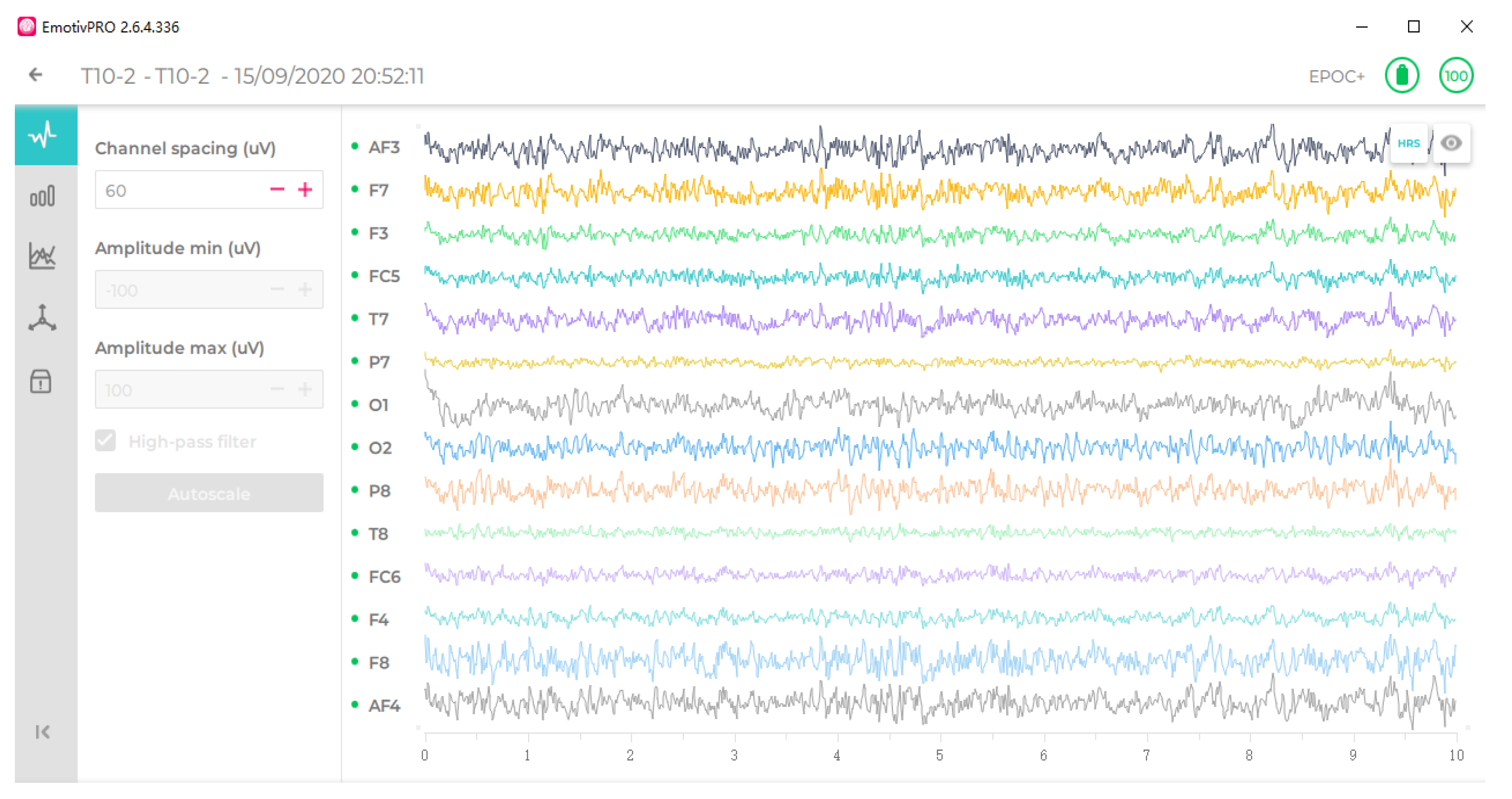
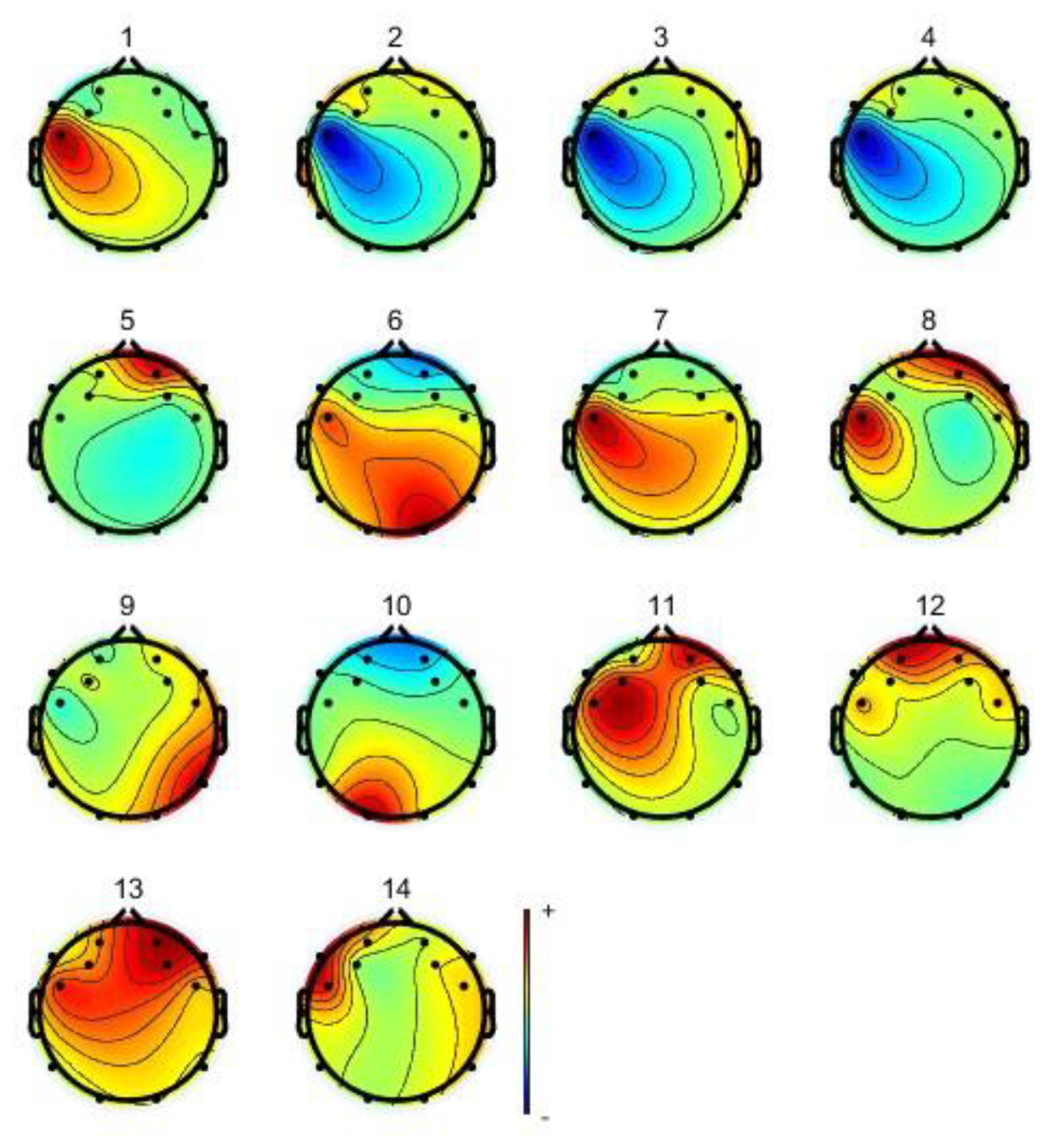

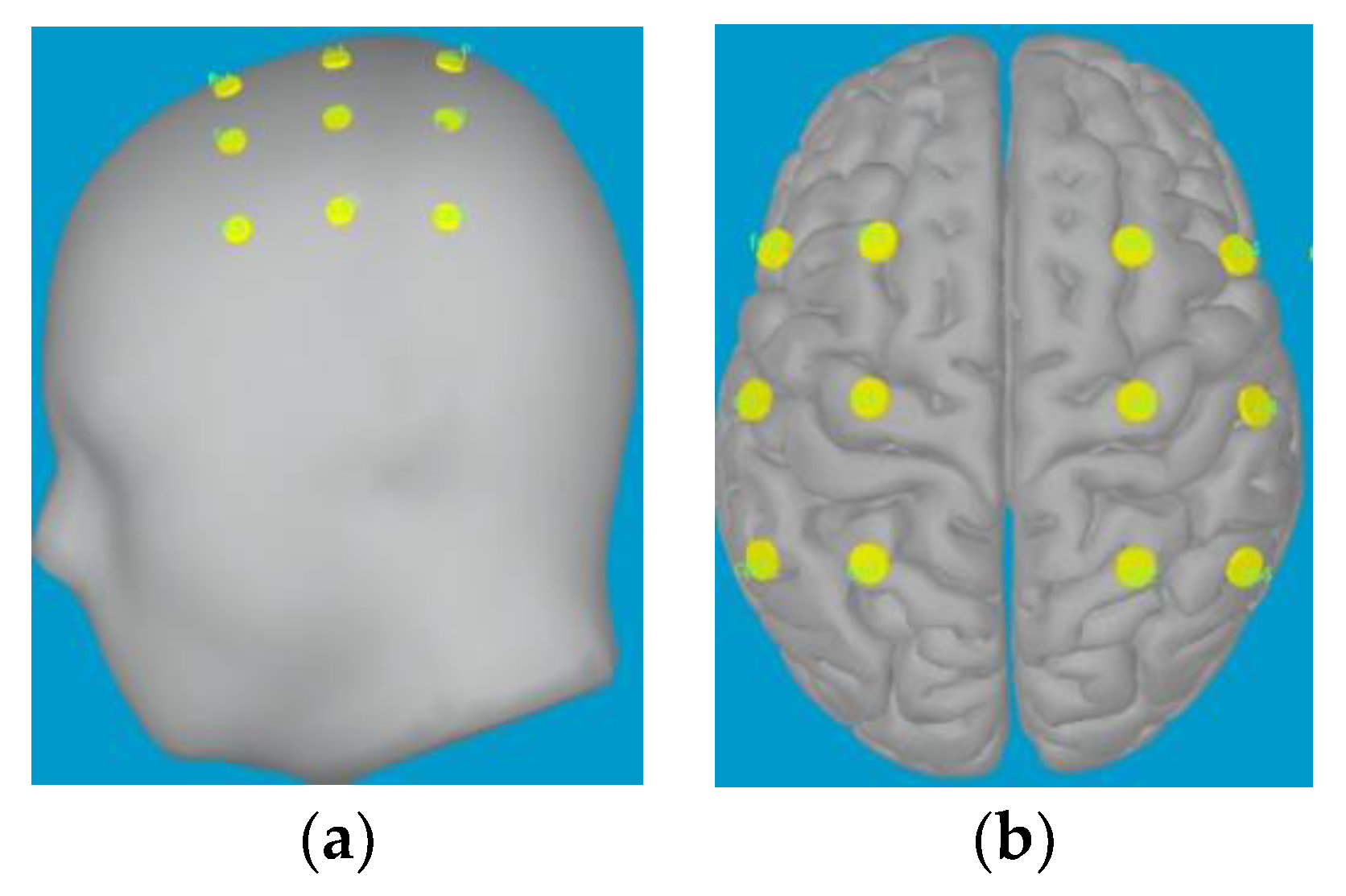

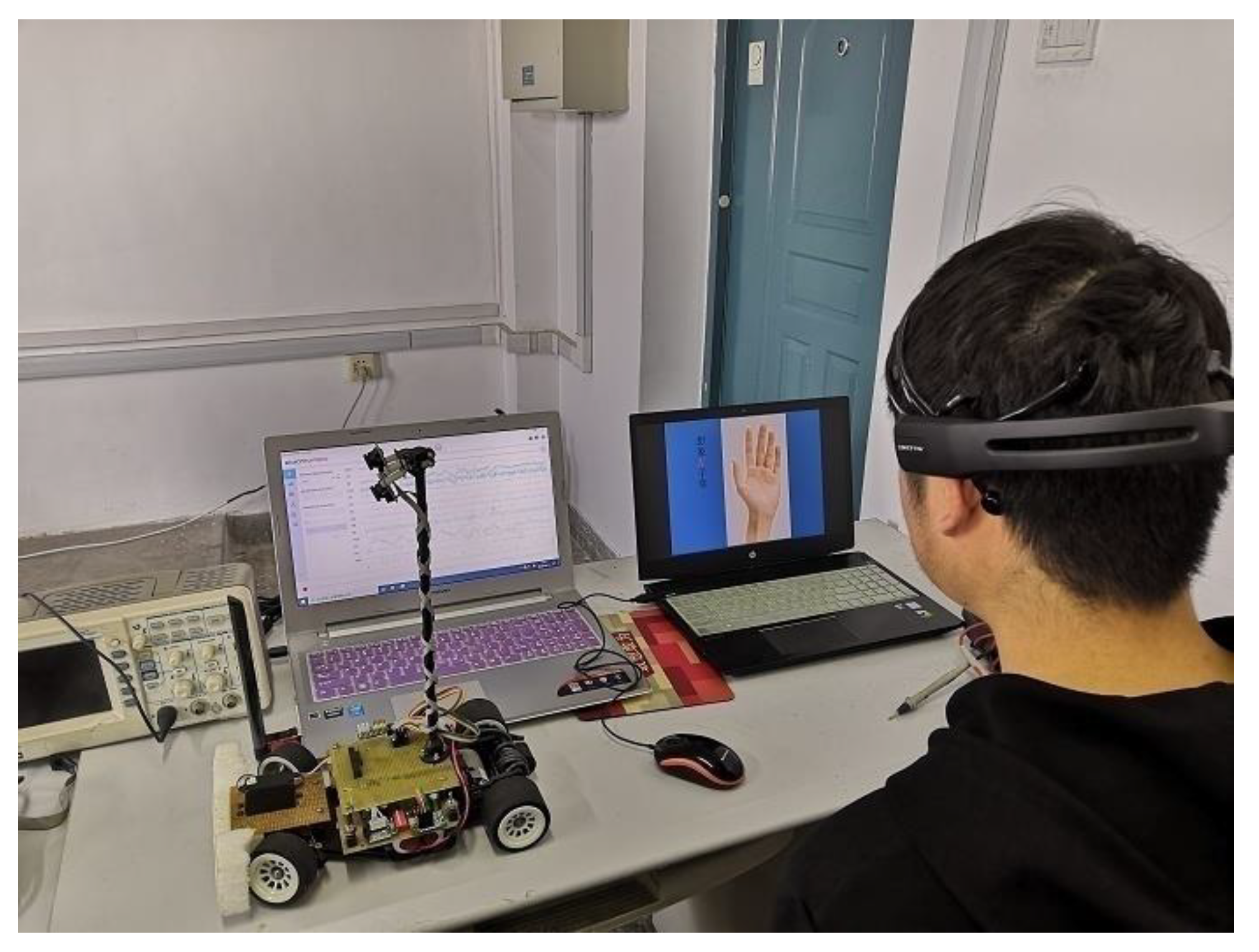

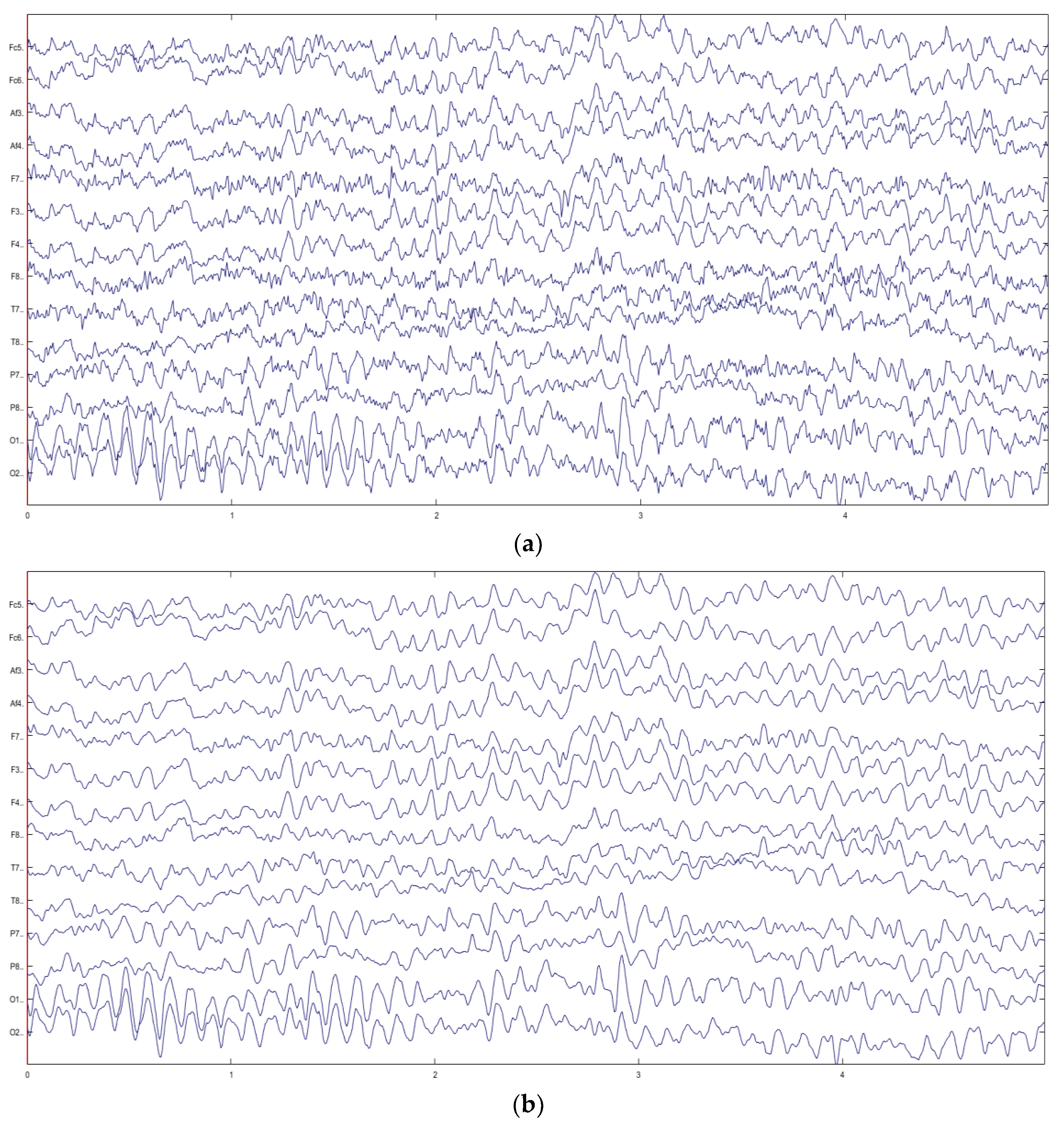
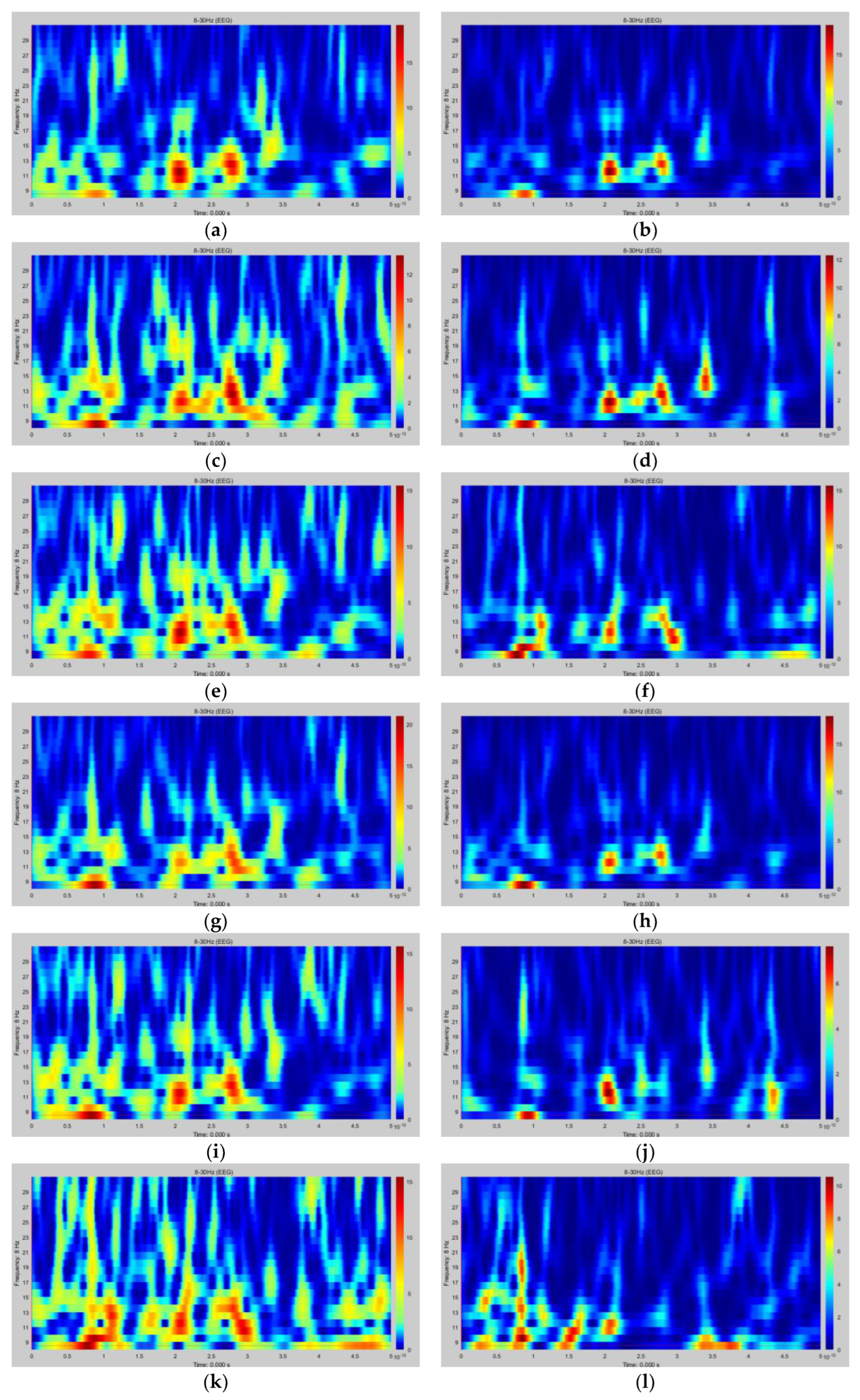
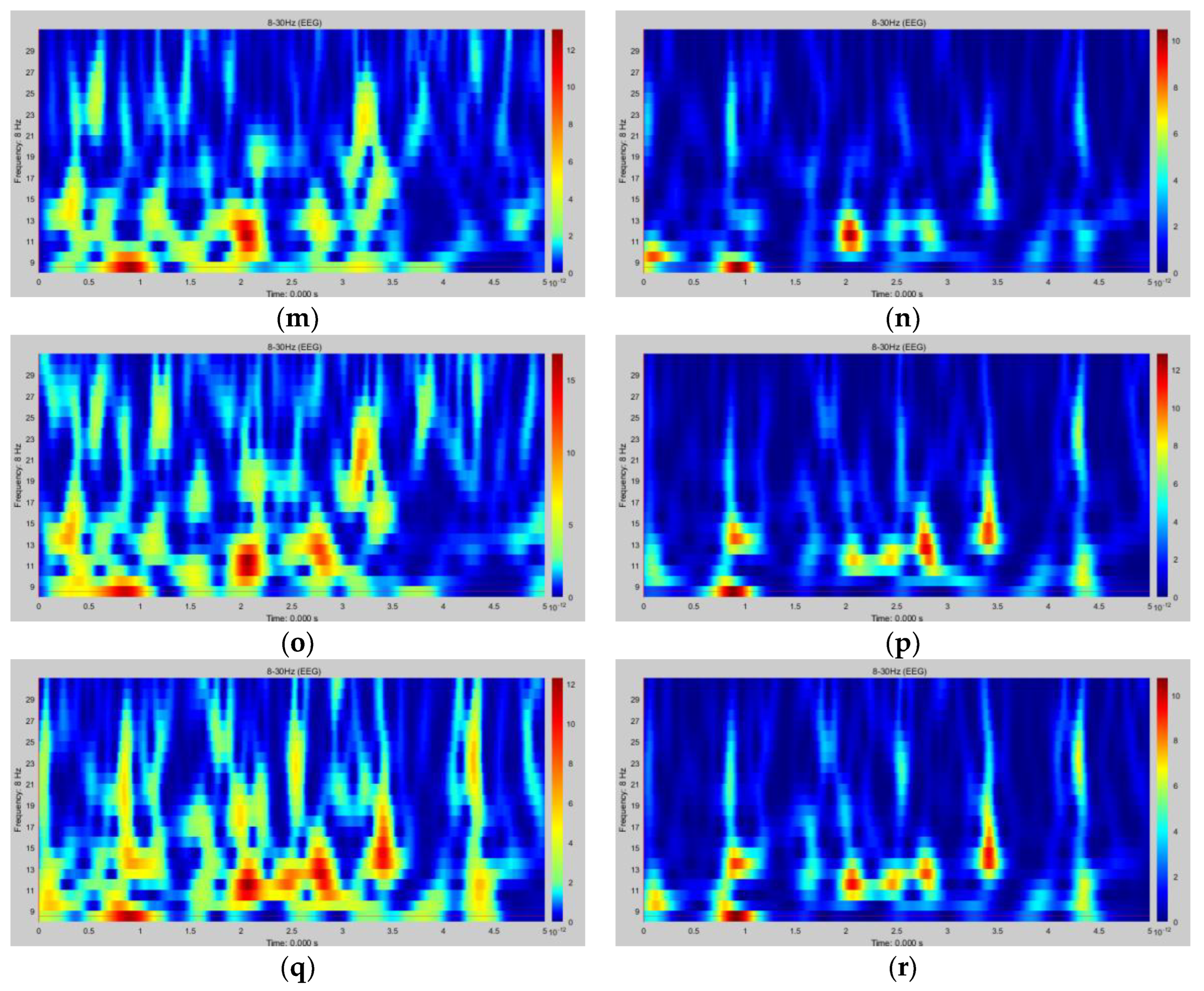
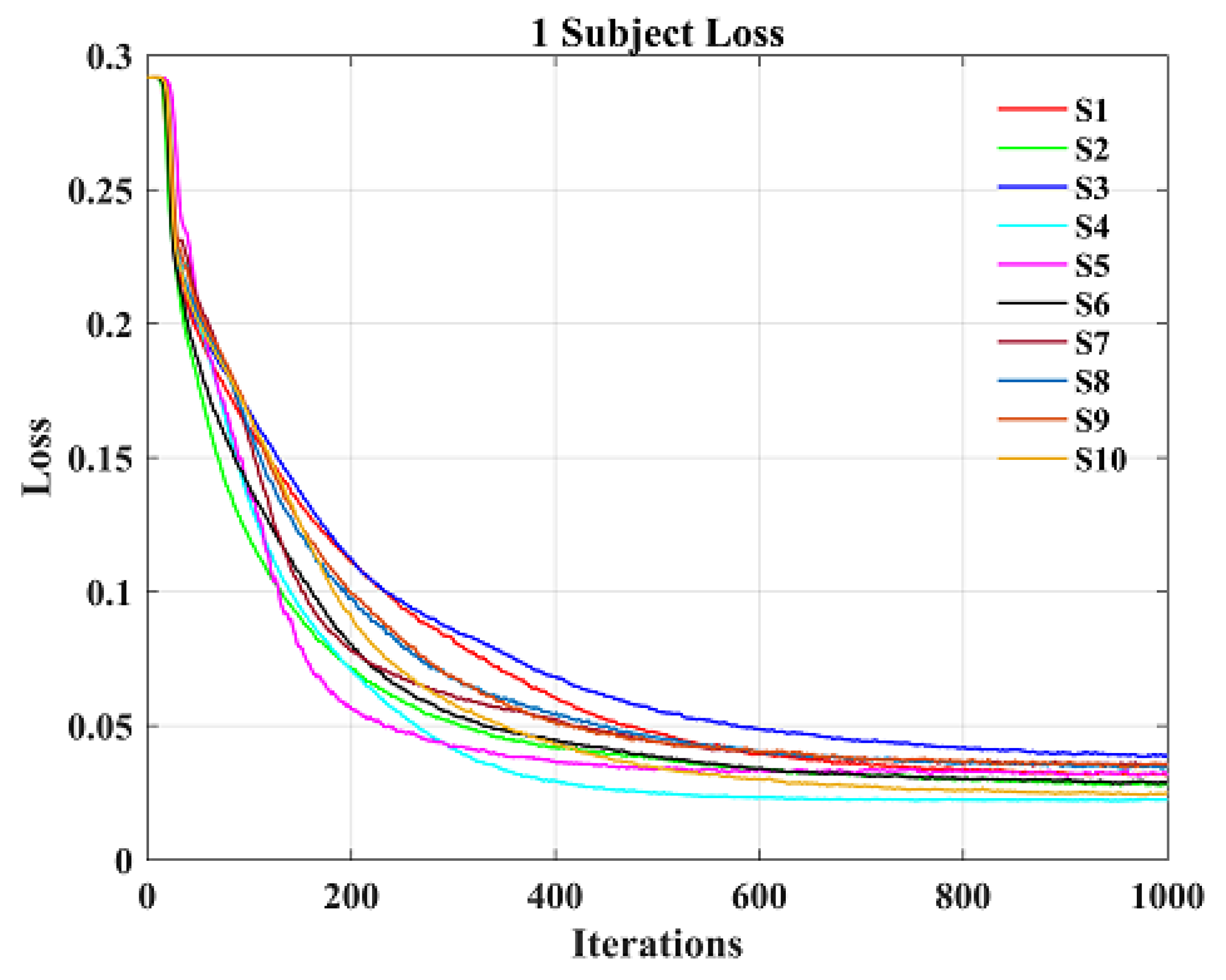
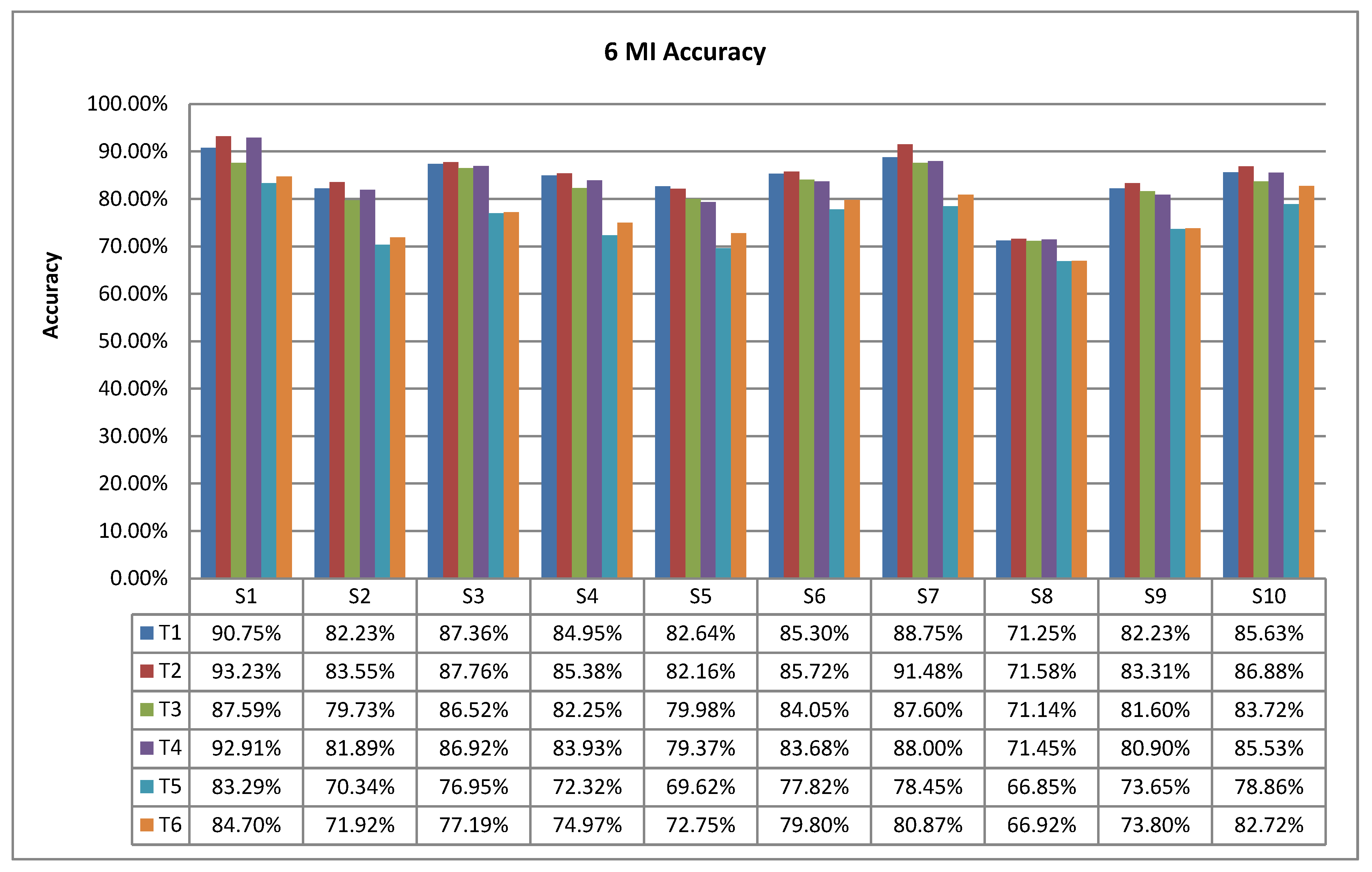

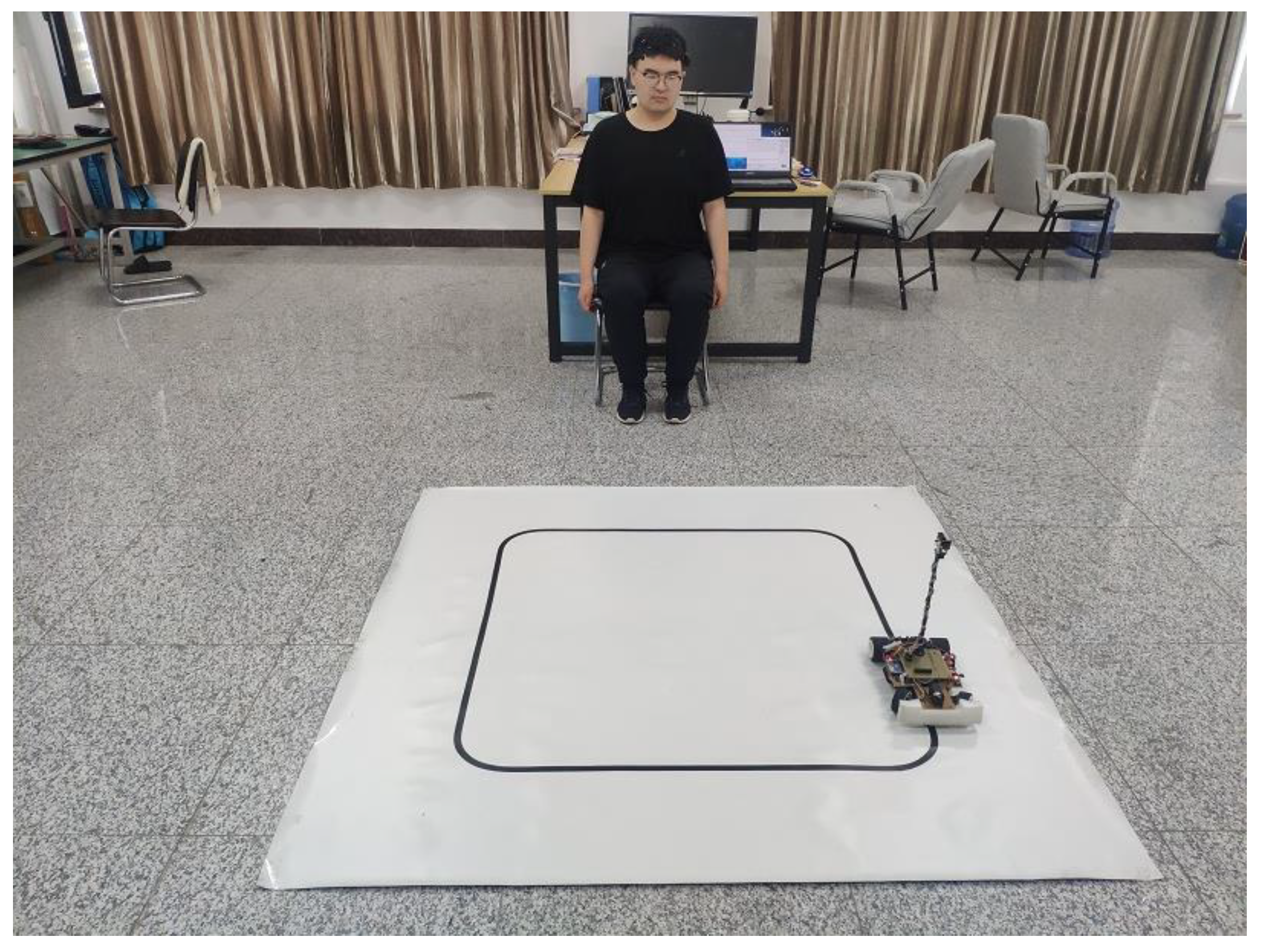



| Layer | Input Size | Map | Convolution Kernel Size | Pooling Size | Activation Function | Stride | Padding | Output Size |
|---|---|---|---|---|---|---|---|---|
| Input | 640 × 46 × 9 | 1 | - | - | - | - | - | 640 × 414 |
| CNN1 | 640 × 414 | 25 | [1, 46] | - | Leaky ReLu | [1, 46] | Valid | 640 × 9 × 25 |
| Pool1 | 640 × 9 × 25 | - | - | [3, 1] | - | [3, 1] | Valid | 213 × 9 × 25 |
| CNN2 | 213 × 9 × 25 | 25 | [1, 9] | - | Leaky ReLu | [1, 1] | Valid | 213 × 25 |
| Pool2 | 213 × 25 | - | - | [3, 1] | - | [3, 1] | Valid | 71 × 25 |
| CNN3 | 71 × 25 | 50 | [11, 25] | - | Leaky ReLu | [1, 1] | Valid | 61 × 50 |
| Pool3 | 61 × 50 | - | - | [3, 1] | - | [3, 1] | Valid | 20 × 50 |
| CNN4 | 20 × 50 | 100 | [11, 50] | - | Leaky ReLu | [1, 1] | Valid | 10 × 100 |
| Pool4 | 10 × 100 | - | - | [3, 1] | - | [3, 1] | Valid | 3 × 100 |
| Flatten | 3 × 100 | 1 | - | - | - | - | - | 300 |
| FC | 300 | 1 | - | - | - | - | - | 6 |
| Output | 6 | 1 | - | - | - | - | - | - |
| Subject | Accuracy | Precision | Recall | F1-Score |
|---|---|---|---|---|
| S1 | 88.75% | 90.45% | 96.60% | 93.42% |
| S2 | 78.28% | 78.57% | 92.44% | 84.94% |
| S3 | 83.78% | 86.39% | 93.38% | 89.75% |
| S4 | 80.63% | 83.57% | 90.70% | 86.99% |
| S5 | 77.75% | 78.99% | 90.83% | 84.50% |
| S6 | 82.73% | 84.83% | 93.18% | 88.81% |
| S7 | 85.86% | 87.42% | 94.96% | 91.03% |
| S8 | 69.87% | 68.75% | 86.27% | 76.52% |
| S9 | 79.25% | 82.48% | 89.68% | 85.93% |
| S10 | 83.39% | 86.30% | 92.65% | 89.36% |
| Average | 81.08% | 82.77% | 92.07% | 87.13% |
| MI | Control Function | Control Instruction |
|---|---|---|
| R-thumb | start | 0 × 01 |
| L- thumb | stop | 0 × 02 |
| R-feet | forward | 0 × 04 |
| L-feet | backward | 0 × 08 |
| R-fist | right | 0 × 10 |
| L-fist | left | 0 × 20 |
| Subject | Mode 1 | Mode 2 | Mode 3 | Mode 4 | Mode 5 | Mode 6 | ||||||
|---|---|---|---|---|---|---|---|---|---|---|---|---|
| S1 | 4 | 3 | 5 | 4 | 4 | 3 | 4 | 4 | 2 | 2 | 0 | 0 |
| S3 | 3 | 3 | 4 | 4 | 3 | 3 | 5 | 4 | 2 | 1 | 1 | 0 |
| S4 | 4 | 4 | 4 | 3 | 4 | 3 | 3 | 2 | 1 | 2 | 0 | 0 |
| S6 | 4 | 3 | 5 | 3 | 3 | 2 | 4 | 3 | 2 | 1 | 1 | 0 |
| S7 | 4 | 2 | 4 | 2 | 4 | 4 | 5 | 3 | 1 | 0 | 1 | 0 |
| S10 | 3 | 3 | 4 | 4 | 3 | 3 | 4 | 4 | 2 | 2 | 0 | 1 |
| SUM | 22 | 18 | 26 | 20 | 21 | 18 | 25 | 20 | 10 | 8 | 3 | 1 |
| Subject | Group | Time (s) | Total Number of Commands | Start | Stop | Forward | Backward | Left | Right |
|---|---|---|---|---|---|---|---|---|---|
| 1 | 616.7 | 63 | 4 | 2 | 19 | 5 | 18 | 15 | |
| S1 | 2 | 522.5 | 55 | 3 | 2 | 24 | 4 | 12 | 10 |
| 3 | 546.3 | 58 | 2 | 2 | 25 | 5 | 12 | 12 | |
| 1 | 670.9 | 65 | 3 | 3 | 18 | 6 | 19 | 16 | |
| S3 | 2 | 706.1 | 70 | 3 | 4 | 17 | 6 | 23 | 17 |
| 3 | 588.0 | 59 | 3 | 2 | 22 | 5 | 15 | 12 | |
| 1 | 696.2 | 65 | 3 | 3 | 15 | 6 | 19 | 19 | |
| S4 | 2 | 759.8 | 75 | 2 | 3 | 10 | 7 | 29 | 24 |
| 3 | 634.2 | 69 | 2 | 2 | 13 | 5 | 22 | 25 | |
| 1 | 635.7 | 61 | 3 | 3 | 17 | 7 | 15 | 16 | |
| S6 | 2 | 674.2 | 67 | 4 | 3 | 15 | 5 | 20 | 20 |
| 3 | 745.5 | 72 | 4 | 2 | 15 | 7 | 21 | 23 | |
| 1 | 752.0 | 70 | 3 | 3 | 11 | 7 | 24 | 22 | |
| S7 | 2 | 700.5 | 67 | 2 | 2 | 11 | 6 | 21 | 25 |
| 3 | 566.0 | 59 | 2 | 3 | 21 | 4 | 15 | 14 | |
| 1 | 643.0 | 63 | 2 | 3 | 16 | 7 | 16 | 19 | |
| S10 | 2 | 803.9 | 79 | 4 | 4 | 11 | 7 | 28 | 25 |
| 3 | 679.6 | 68 | 2 | 3 | 15 | 6 | 23 | 19 |
| Subject | Group | Time (s) | Total Number of Commands | Start | Stop | Forward | Backward | Left | Right |
|---|---|---|---|---|---|---|---|---|---|
| 1 | 535.1 | 72 | 7 | 7 | 17 | 6 | 17 | 18 | |
| S1 | 2 | 473.3 | 68 | 6 | 7 | 16 | 5 | 18 | 16 |
| 3 | 443.5 | 65 | 5 | 5 | 20 | 4 | 17 | 14 | |
| 1 | 526.8 | 77 | 6 | 5 | 15 | 7 | 24 | 20 | |
| S3 | 2 | 586.9 | 85 | 8 | 9 | 12 | 7 | 23 | 26 |
| 3 | 518.7 | 79 | 8 | 8 | 15 | 5 | 23 | 20 | |
| 1 | 632.5 | 93 | 11 | 9 | 11 | 5 | 31 | 26 | |
| S4 | 2 | 578.2 | 82 | 9 | 9 | 15 | 8 | 22 | 19 |
| 3 | 534.7 | 73 | 6 | 4 | 15 | 7 | 21 | 20 | |
| 1 | 549.2 | 87 | 9 | 7 | 13 | 7 | 25 | 26 | |
| S6 | 2 | 528.0 | 75 | 7 | 8 | 16 | 8 | 19 | 17 |
| 3 | 499.1 | 72 | 5 | 5 | 17 | 4 | 22 | 19 | |
| 1 | 503.8 | 78 | 9 | 8 | 15 | 7 | 20 | 19 | |
| S7 | 2 | 510.1 | 72 | 7 | 8 | 18 | 5 | 18 | 16 |
| 3 | 546.8 | 75 | 9 | 8 | 15 | 5 | 20 | 18 | |
| 1 | 612.0 | 90 | 12 | 13 | 13 | 7 | 26 | 19 | |
| S10 | 2 | 542.2 | 79 | 9 | 8 | 18 | 7 | 18 | 19 |
| 3 | 552.9 | 75 | 7 | 7 | 17 | 5 | 22 | 17 |
| Subject | Accuracy | Precision | Recall | F1-Score |
|---|---|---|---|---|
| S1 | +16.54% | +14.87% | +17.28% | +16.02% |
| S2 | +9.96% | +12.90% | +21.72% | +16.84% |
| S3 | +18.46% | +17.81% | +21.94% | +19.77% |
| S4 | +10.33% | +13.36% | +22.44% | +17.77% |
| S5 | +17.14% | +16.78% | +19.35% | +17.97% |
| S6 | +13.41% | +19.60% | +19.28% | +19.51% |
| S7 | +20.51% | +19.06% | +26.46% | +22.60% |
| S8 | +13.66% | +10.44% | +25.06% | +16.80% |
| S9 | +11.91% | +17.16% | +21.08% | +19.01% |
| S10 | +18.30% | +13.55% | +24.77% | +19.13% |
| Subject | Accuracy | Precision | Recall | F1-Score |
|---|---|---|---|---|
| S11 | 78.00% | 77.36% | 78.75% | 78.05% |
| S12 | 74.11% | 72.73% | 76.79% | 74.70% |
| S13 | 82.11% | 83.52% | 80.40% | 81.93% |
| Average | 78.07% | 77.87% | 78.64% | 78.23% |
| Literature | MI Task | Average Accuracy | Dataset | Method |
|---|---|---|---|---|
| Handiru V S et al. [69] | 2 | 63.62% | PhysioNet | IMOS + SVM |
| Youngjoo K et al. [70] | 2 | 80.05% | PhysioNet | SUTCCSP + RF |
| Ma X et al. [71] | 4 | 68.20% | PhysioNet | RNNs |
| 2 | 86.49% | |||
| Hauke Dose et al. [13] | 3 | 79.25% | PhysioNet | CNN |
| 4 | 68.51% | |||
| Hou Y et al. [72] | 4 | 94.50% | PhysioNet | CNN |
| Alyasseri Z et al. [73] | 4 | 96.08% | PhysioNet | SVM |
| This work | 4 | 97.83% | PhysioNet | ESA + CNN |
Disclaimer/Publisher’s Note: The statements, opinions and data contained in all publications are solely those of the individual author(s) and contributor(s) and not of MDPI and/or the editor(s). MDPI and/or the editor(s) disclaim responsibility for any injury to people or property resulting from any ideas, methods, instructions or products referred to in the content. |
© 2023 by the authors. Licensee MDPI, Basel, Switzerland. This article is an open access article distributed under the terms and conditions of the Creative Commons Attribution (CC BY) license (https://creativecommons.org/licenses/by/4.0/).
Share and Cite
Lun, X.; Zhang, Y.; Zhu, M.; Lian, Y.; Hou, Y. A Combined Virtual Electrode-Based ESA and CNN Method for MI-EEG Signal Feature Extraction and Classification. Sensors 2023, 23, 8893. https://doi.org/10.3390/s23218893
Lun X, Zhang Y, Zhu M, Lian Y, Hou Y. A Combined Virtual Electrode-Based ESA and CNN Method for MI-EEG Signal Feature Extraction and Classification. Sensors. 2023; 23(21):8893. https://doi.org/10.3390/s23218893
Chicago/Turabian StyleLun, Xiangmin, Yifei Zhang, Mengyang Zhu, Yongheng Lian, and Yimin Hou. 2023. "A Combined Virtual Electrode-Based ESA and CNN Method for MI-EEG Signal Feature Extraction and Classification" Sensors 23, no. 21: 8893. https://doi.org/10.3390/s23218893
APA StyleLun, X., Zhang, Y., Zhu, M., Lian, Y., & Hou, Y. (2023). A Combined Virtual Electrode-Based ESA and CNN Method for MI-EEG Signal Feature Extraction and Classification. Sensors, 23(21), 8893. https://doi.org/10.3390/s23218893





